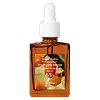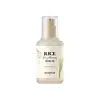What's inside
What's inside
 Key Ingredients
Key Ingredients

 Benefits
Benefits

 Concerns
Concerns

No concerns
 Ingredients Side-by-side
Ingredients Side-by-side

Hippophae Rhamnoides Water
MaskingCentella Asiatica Leaf Water
Skin ConditioningNiacinamide
SmoothingButylene Glycol
Humectant1,2-Hexanediol
Skin ConditioningDipropylene Glycol
HumectantWater
Skin ConditioningMethyl Gluceth-20
HumectantMethylpropanediol
SolventBetaine
HumectantTranexamic Acid
AstringentGlycerin
HumectantPentylene Glycol
Skin ConditioningPropanediol
SolventHydroxyethyl Urea
HumectantLaminaria Japonica Extract
Skin ProtectingEclipta Prostrata Leaf Extract
Skin ConditioningFicus Carica Fruit Extract
HumectantCentella Asiatica Extract
CleansingHydrogenated Lecithin
EmulsifyingSodium Hyaluronate
HumectantCarbomer
Emulsion Stabilising3-O-Ethyl Ascorbic Acid
Skin ConditioningC12-14 Pareth-12
EmulsifyingAmmonium Acryloyldimethyltaurate/Vp Copolymer
Xanthan Gum
EmulsifyingTromethamine
BufferingPanthenol
Skin ConditioningEthylhexylglycerin
Skin ConditioningAdenosine
Skin ConditioningDisodium EDTA
Fructooligosaccharides
HumectantBeta-Glucan
Skin ConditioningAscorbic Acid
AntioxidantHydrolyzed Hyaluronic Acid
HumectantCeramide NP
Skin ConditioningAlpha-Arbutin
AntioxidantTocopherol
AntioxidantBifida Ferment Lysate
Skin ConditioningBisabolol
MaskingUbiquinone
AntioxidantHydroxydecyl Ubiquinone
AntioxidantSodium Acetylated Hyaluronate
HumectantHippophae Rhamnoides Water, Centella Asiatica Leaf Water, Niacinamide, Butylene Glycol, 1,2-Hexanediol, Dipropylene Glycol, Water, Methyl Gluceth-20, Methylpropanediol, Betaine, Tranexamic Acid, Glycerin, Pentylene Glycol, Propanediol, Hydroxyethyl Urea, Laminaria Japonica Extract, Eclipta Prostrata Leaf Extract, Ficus Carica Fruit Extract, Centella Asiatica Extract, Hydrogenated Lecithin, Sodium Hyaluronate, Carbomer, 3-O-Ethyl Ascorbic Acid, C12-14 Pareth-12, Ammonium Acryloyldimethyltaurate/Vp Copolymer, Xanthan Gum, Tromethamine, Panthenol, Ethylhexylglycerin, Adenosine, Disodium EDTA, Fructooligosaccharides, Beta-Glucan, Ascorbic Acid, Hydrolyzed Hyaluronic Acid, Ceramide NP, Alpha-Arbutin, Tocopherol, Bifida Ferment Lysate, Bisabolol, Ubiquinone, Hydroxydecyl Ubiquinone, Sodium Acetylated Hyaluronate
Water
Skin ConditioningButylene Glycol
HumectantGlycerin
HumectantIsopentyldiol
HumectantPolyglycerin-3
Humectant1,2-Hexanediol
Skin ConditioningNiacinamide
SmoothingCaprylic/Capric Triglyceride
MaskingCetearyl Olivate
Betaine
HumectantAmmonium Acryloyldimethyltaurate/Vp Copolymer
Sorbitan Olivate
EmulsifyingGlyceryl Stearate
EmollientEthylhexylglycerin
Skin ConditioningXanthan Gum
EmulsifyingAdenosine
Skin ConditioningOryza Sativa Extract
AbsorbentOryza Sativa Bran Water
MaskingOryza Sativa Seed Water
AntimicrobialAspergillus Ferment
Skin ConditioningDipotassium Glycyrrhizate
HumectantGlycine
BufferingSerine
MaskingGlutamic Acid
HumectantAspartic Acid
MaskingLeucine
Skin ConditioningAlanine
MaskingLysine
Skin ConditioningArginine
MaskingTyrosine
MaskingPhenylalanine
MaskingProline
Skin ConditioningThreonine
Valine
MaskingIsoleucine
Skin ConditioningHistidine
HumectantMethionine
Skin ConditioningCysteine
AntioxidantHydrolyzed Rice Protein
Skin ConditioningGluconolactone
Skin ConditioningCaprylhydroxamic Acid
Trehalose
HumectantSh-Oligopeptide-1
Skin ConditioningProtease
ExfoliatingDisodium EDTA
Parfum
MaskingWater, Butylene Glycol, Glycerin, Isopentyldiol, Polyglycerin-3, 1,2-Hexanediol, Niacinamide, Caprylic/Capric Triglyceride, Cetearyl Olivate, Betaine, Ammonium Acryloyldimethyltaurate/Vp Copolymer, Sorbitan Olivate, Glyceryl Stearate, Ethylhexylglycerin, Xanthan Gum, Adenosine, Oryza Sativa Extract, Oryza Sativa Bran Water, Oryza Sativa Seed Water, Aspergillus Ferment, Dipotassium Glycyrrhizate, Glycine, Serine, Glutamic Acid, Aspartic Acid, Leucine, Alanine, Lysine, Arginine, Tyrosine, Phenylalanine, Proline, Threonine, Valine, Isoleucine, Histidine, Methionine, Cysteine, Hydrolyzed Rice Protein, Gluconolactone, Caprylhydroxamic Acid, Trehalose, Sh-Oligopeptide-1, Protease, Disodium EDTA, Parfum
 Reviews
Reviews

Ingredients Explained
These ingredients are found in both products.
Ingredients higher up in an ingredient list are typically present in a larger amount.
1,2-Hexanediol is a synthetic liquid and another multi-functional powerhouse.
It is a:
- Humectant, drawing moisture into the skin
- Emollient, helping to soften skin
- Solvent, dispersing and stabilizing formulas
- Preservative booster, enhancing the antimicrobial activity of other preservatives
Adenosine is in every living organism. It is one of four components in nucleic acids that helps store our DNA.
Adenosine has many benefits when used. These benefits include hydrating the skin, smoothing skin, and reducing wrinkles. Once applied, adenosine increases collagen production. It also helps with improving firmness and tissue repair.
Studies have found adenosine may also help with wound healing.
In skincare products, Adenosine is usually derived from yeast.
Learn more about AdenosineAmmonium Acryloyldimethyltaurate/Vp Copolymer (let's call it AAVC for short) is a synthetically created polymer. It's used as a film-forming agent and used to thicken the consistency of products.
AAVC is able to increase the consistency and viscosity of products due to its large molecule size. It also prevents ingredients from separating.
Betaine is a common humectant (a substance that promotes retention of moisture). It's known to be gentle on the skin and can help balance hydration.
This ingredient is best for improving hydration and soothing irritated skin. Studies also show it helps even out skin tone.
Fun fact: Betaine is naturally created in the skin and body. The kind found within cosmetic products can be either plant-derived or synthetic.
Another name for betaine is trimethylglycine.
Learn more about BetaineButylene Glycol (or BG) is used within cosmetic products for a few different reasons:
Overall, Butylene Glycol is a safe and well-rounded ingredient that works well with other ingredients.
Though this ingredient works well with most skin types, some people with sensitive skin may experience a reaction such as allergic rashes, closed comedones, or itchiness.
Learn more about Butylene GlycolDisodium EDTA plays a role in making products more stable by aiding other preservatives.
It is a chelating agent, meaning it neutralizes metal ions that may be found in a product.
Disodium EDTA is a salt of edetic acid and is found to be safe in cosmetic ingredients.
Learn more about Disodium EDTAEthylhexylglycerin (we can't pronounce this either) is commonly used as a preservative and skin softener. It is derived from glyceryl.
You might see Ethylhexylglycerin often paired with other preservatives such as phenoxyethanol. Ethylhexylglycerin has been found to increase the effectiveness of these other preservatives.
Glycerin is already naturally found in your skin. It helps moisturize and protect your skin.
A study from 2016 found glycerin to be more effective as a humectant than AHAs and hyaluronic acid.
As a humectant, it helps the skin stay hydrated by pulling moisture to your skin. The low molecular weight of glycerin allows it to pull moisture into the deeper layers of your skin.
Hydrated skin improves your skin barrier; Your skin barrier helps protect against irritants and bacteria.
Glycerin has also been found to have antimicrobial and antiviral properties. Due to these properties, glycerin is often used in wound and burn treatments.
In cosmetics, glycerin is usually derived from plants such as soybean or palm. However, it can also be sourced from animals, such as tallow or animal fat.
This ingredient is organic, colorless, odorless, and non-toxic.
Glycerin is the name for this ingredient in American English. British English uses Glycerol/Glycerine.
Learn more about GlycerinNiacinamide is a multitasking form of vitamin B3 that strengthens the skin barrier, reduces pores and dark spots, regulates oil, and improves signs of aging.
And the best part? It's gentle and well-tolerated by most skin types, including sensitive and reactive skin.
You might have heard of "niacin flush", or the reddening of skin that causes itchiness. Niacinamide has not been found to cause this.
In very rare cases, some individuals may not be able to tolerate niacinamide at all or experience an allergic reaction to it.
If you are experiencing flaking, irritation, and dryness with this ingredient, be sure to double check all your products as this ingredient can be found in all categories of skincare.
When incorporating niacinamide into your routine, look out for concentration amounts. Typically, 5% niacinamide provides benefits such as fading dark spots. However, if you have sensitive skin, it is better to begin with a smaller concentration.
When you apply niacinamide to your skin, your body converts it into nicotinamide adenine dinucleotide (NAD). NAD is an essential coenzyme that is already found in your cells as "fuel" and powers countless biological processes.
In your skin, NAD helps repair cell damage, produce new healthy cells, support collagen production, strengthen the skin barrier, and fight environmental stressors (like UV and pollution).
Our natural NAD levels start to decline with age, leading to slower skin repair, visible aging, and a weaker skin barrier. By providing your skin niacinamide, you're recharging your skin's NAD levels. This leads to stronger, healthier, and younger looking skin.
Another name for vitamin B3 is nicotinamide. This vitamin is water-soluble and our bodies don't store it. We obtain Vitamin B3 from either food or skincare. Meat, fish, wheat, yeast, and leafy greens contain vitamin B3.
The type of niacinamide used in skincare is synthetically created.
Learn more about NiacinamideWater. It's the most common cosmetic ingredient of all. You'll usually see it at the top of ingredient lists, meaning that it makes up the largest part of the product.
So why is it so popular? Water most often acts as a solvent - this means that it helps dissolve other ingredients into the formulation.
You'll also recognize water as that liquid we all need to stay alive. If you see this, drink a glass of water. Stay hydrated!
Learn more about WaterXanthan gum is used as a stabilizer and thickener within cosmetic products. It helps give products a sticky, thick feeling - preventing them from being too runny.
On the technical side of things, xanthan gum is a polysaccharide - a combination consisting of multiple sugar molecules bonded together.
Xanthan gum is a pretty common and great ingredient. It is a natural, non-toxic, non-irritating ingredient that is also commonly used in food products.
Learn more about Xanthan Gum